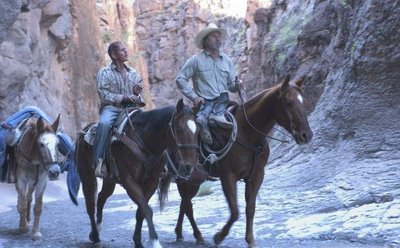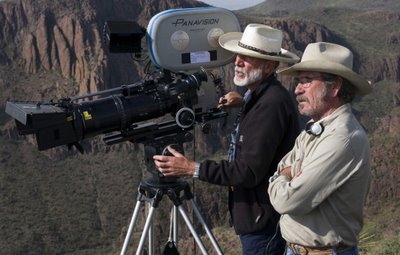
I didn't intend a study in contrasts--and perhaps comparisons--as I follow up Nacho Libre with The Three Burials of Melquiades Estrada; but I do think Tommy Lee Jones' movie shares Nacho's indulgences in the outre--except Three Burials is almost Lynchian in its exploration of friendship within the context of the Western, while Nacho is just plain silly, as Daffy Duck would say. In Three Burials, Jones gives us a story and a style that fits the Western in more ways than one: Its abrupt shifts and sudden transitions remind me of the rhythms of a campfire tale--or reminiscence--one you kinda sneak up on, then linger over, then slide by, then linger again, all the while jumping around as one detail reminds you of another. At first a bit disorienting, Jones' technique soon found me right where it wanted me: hunched expectantly by the crackling logs, my poncho pulled tight against the night, my eyes following the teller's as he laid out the beginning of the middle, then the beginning, then on to the end.
 And what a tall tale Jones does tell, ably aided by Barry Pepper as the bull-moose knucklehead border patrolman who shoots the titular thrice-buried character--who in turn forms the grisly third in this sagebrush deathmarch. Sometimes comical, always Texas-flat-true, Three Burials begins as a puzzle and ends as a rumination on the ties that bind, as well as a cockeyed opportunity for redemption, for Jones' Pete Perkins as much as Pepper's Mike Norton. And as much as I enjoyed watching Jones--like Robert Duvall in Open Range, Jones has a grand time playing cowboy--I want to mention Pepper's pitch-perfect turn here. Doesn't he have one of the great American faces of the past decade? A weirdly bent straight arrow whose trials send him scurrying like a snakebit greenhorn--literally--toward self-awareness and what looks like the first real tears of his life.
And what a tall tale Jones does tell, ably aided by Barry Pepper as the bull-moose knucklehead border patrolman who shoots the titular thrice-buried character--who in turn forms the grisly third in this sagebrush deathmarch. Sometimes comical, always Texas-flat-true, Three Burials begins as a puzzle and ends as a rumination on the ties that bind, as well as a cockeyed opportunity for redemption, for Jones' Pete Perkins as much as Pepper's Mike Norton. And as much as I enjoyed watching Jones--like Robert Duvall in Open Range, Jones has a grand time playing cowboy--I want to mention Pepper's pitch-perfect turn here. Doesn't he have one of the great American faces of the past decade? A weirdly bent straight arrow whose trials send him scurrying like a snakebit greenhorn--literally--toward self-awareness and what looks like the first real tears of his life. But what I enjoyed most of all was Jones' direction. The film's structure, as I've mentioned, picks its way through the story in true Western rambling narrative style--but more than that is the laconic-terse editing rhythm that becomes the visual equivalent of the Gary Cooper yup-nope, marking more than anything the myth of the cowboy. Jones doesn't fuss with establishing shots or slow dissolves; instead, we see what's important--or what will be--then turn around and move on. Sometimes the scenes go by with a drawl; at others, it's barely a glance, but enough to let us know we should be watching. It is the invisible American style made visible, and the effect is often oddly comic, a bit distancing, like the campfire teller who doesn't want to get all mushy on you--then it stops, and makes you see how bad things have gotten--the ant-episode stands out as a dark-comic version of this; but in a more awful, poignant way so does the blind-man scene. And finally Jones reaches the punchline--which merely works as a rueful shrug, preceded by necessary tears and resignation, before the movie provides its own truncated version of the ride into the sunset. Pepper even gets to yelp out a Shane-like cry before the movie packs it in, quick but unhurried, a "nope" followed by a "yup." You need to watch fast, Jones' draw is so quick.
But what I enjoyed most of all was Jones' direction. The film's structure, as I've mentioned, picks its way through the story in true Western rambling narrative style--but more than that is the laconic-terse editing rhythm that becomes the visual equivalent of the Gary Cooper yup-nope, marking more than anything the myth of the cowboy. Jones doesn't fuss with establishing shots or slow dissolves; instead, we see what's important--or what will be--then turn around and move on. Sometimes the scenes go by with a drawl; at others, it's barely a glance, but enough to let us know we should be watching. It is the invisible American style made visible, and the effect is often oddly comic, a bit distancing, like the campfire teller who doesn't want to get all mushy on you--then it stops, and makes you see how bad things have gotten--the ant-episode stands out as a dark-comic version of this; but in a more awful, poignant way so does the blind-man scene. And finally Jones reaches the punchline--which merely works as a rueful shrug, preceded by necessary tears and resignation, before the movie provides its own truncated version of the ride into the sunset. Pepper even gets to yelp out a Shane-like cry before the movie packs it in, quick but unhurried, a "nope" followed by a "yup." You need to watch fast, Jones' draw is so quick.I'd like to see Tommy Lee Jones do this kind of thing more often. He has that cowboy-quality down to the bone, even when he's battling aliens and Wil Smith's distinctly East-coast bravado. It can be a parody of itself--again, his Man in Black is more Keaton than Cash--but even then it has its charm. On the other hand, when he focuses those qualities on something like Three Burials, Jones lets us see the value of that slow-to-anger-quick-in-judgment Western icon, the last man standing, even when all that remains is lies and loss, and a last question.

No comments:
Post a Comment